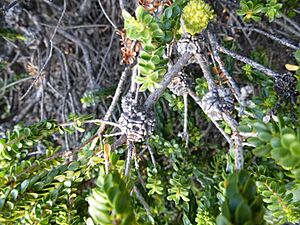Phymatocarpus porphyrocephalus facts for kids
Quick facts for kids Phymatocarpus porphyrocephalus |
|
|---|---|
 |
|
| Scientific classification | |
| Genus: |
Phymatocarpus
|
| Species: |
porphyrocephalus
|
| Synonyms | |
|
Melaleuca porphyrocephala (F.Muell.) Craven & R.D.Edwards |
|
Phymatocarpus porphyrocephalus is a cool plant from the Myrtaceae family, which is also known as the myrtle family. This plant only grows naturally in the south-west part of Western Australia. It looks a lot like some smaller Melaleuca plants. The main difference is how its pollen-carrying parts, called anthers, are attached. In Phymatocarpus, these anthers are joined at their bottom and open up at the top to release pollen. This plant is a shrub that often gets covered in many small, round clusters of pink or purple flowers. These flowers slowly turn white and can bloom for several weeks during springtime.
What It Looks Like
Phymatocarpus porphyrocephalus is a shrub that can grow straight up or spread out. It can reach about 2 metres (6.6 feet) tall and wide. Its leaves grow one after another along the stem. They are usually 4 to 6 millimetres (0.16 to 0.24 inches) long. The leaves are wide and oval-shaped, sometimes almost round. They usually have 1 to 3 small lines, or veins, running through them.
The flowers are pink to purple at first, then fade to white. They grow in tight, round groups at the ends of branches. These branches keep growing even after the flowers bloom. Each flower has small, leaf-like parts called bracts at its base. It also has 5 sepals (which protect the bud), 5 petals, and between 46 and 71 stamens. The stamens are the parts that make pollen. They form a continuous ring around the edge of each flower.
This plant usually flowers from August to December. After the flowers, it grows woody fruits called capsules. These capsules are grouped together in round clusters. The outside of these clusters feels rough or lumpy.

Plant Names and History
Phymatocarpus porphyrocephalus was the very first plant in its group, Phymatocarpus, to be officially described. This happened in 1862. A scientist named Ferdinand von Mueller wrote about it in his book, Fragmenta Phytographiae Australiae.
The second part of its scientific name, porphyrocephalus, comes from two Ancient Greek words. Porphúra means "purple," and kephalḗ means "head." This name describes the plant's purple, head-like flower clusters.
Where It Grows
You can find Phymatocarpus porphyrocephalus in Western Australia. It grows in the areas between the Murchison River and Eneabba. It likes to grow in sandy soil that is on top of sandstone or limestone. You can often see it on flat, sandy plains or in rocky valleys near the coast.
How It's Protected
The Western Australian government's Department of Parks and Wildlife checks on plants like Phymatocarpus porphyrocephalus. They have classified this plant as "not threatened." This means it is not currently in danger of disappearing.


